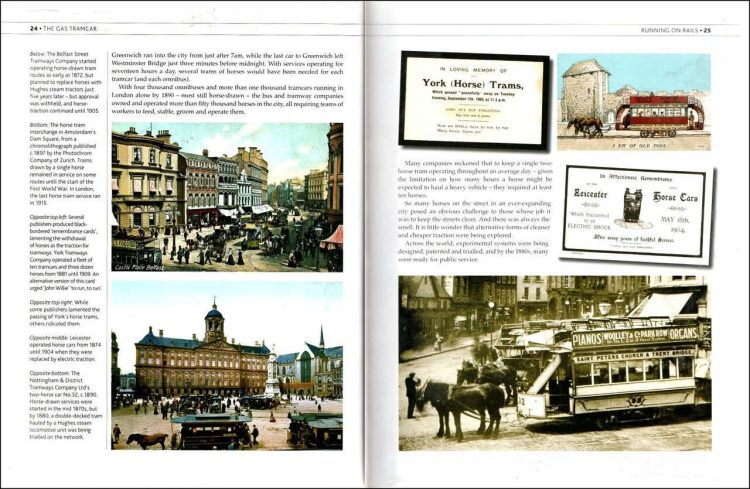This book describes a phenomenon that for a short period of time seemed to herald quieter and smoother travel by replacing trams pulled by horses and steam locomotives with ones powered by gas.
Published in November 2022 as part of Pen & Sword's “Train Craft” series and written by John Hannavy, this book measures around 22.23 cm x 28.58 cm and has 208 pages, 100 colour and 100 black and white illustrations. It has a published price of £35, but at the time of writing Pen & Sword has it on offer online for £24.50 and it can be obtained from Amazon for £21.00.
Although the book is titled The Gas Tramcar, it doesn't solely concentrate on that aspect as in 13 chapters it traces the history of trams from horse-drawn carriages on roads, to placing the carriages on rails, replacing horses with mechanical propulsion, first by steam, then various other methods including electricity, batteries, cable haulage, oil, and compressed air. It's not until Chapter 6 that the book talks about the possibility of using gas, but at first concentrates on how the gas was produced and how the early engines powered by gas were used to drive machinery in factories.
An extensive chapter on the first gas-powered tramcars includes some very detailed design drawings of the concept. There follows a description of the handful of British tramway companies that used them, with only three ever using them on regular services and less than three dozen such vehicles being used in Britain, but that was almost half the world's total.
As electricity use became widespread, tramcars powered by gas became obsolete, but the author devotes a chapter to discussing whether gas has a future in powering tramcars.
In over one hundred years up to the beginning of the twentieth century, many patents were taken out for novel developments connected with gas-powered tramcars, and the book includes 16 pages with a sample selection of these patents.
Just as the passing of steam on British Railways was mourned, so it was with the passing of horse-drawn-powered trams, and many “In Memoriam” cards were published to commemorate their demise, such as those on the right below. Later in the book are illustrations showing similar cards when electric cars replaced steam-powered trams.

A feature of the book is the large number of very detailed illustrations, such as those seen below.
Many illustrations are taken from patent applications such as those below, which clearly show the patentee's designs.
To our eyes, the early gas-powered tramcars look odd, more so as their left and right sides had different appearances as can be seen on the left-hand page below.
The illustrations below give a clear idea of the concept behind gas-powered tramcars. At the top-right is a photograph of one example of the Deptford and Greenwich Tramway, which was the first in Britain to carry fare-paying passengers on a tram hauled by a gas-engined vehicle.
The illustration on the left below gives a good idea of the gas-powered tramcar's mechanics, with a large flywheel to keep the engine running smoothly and two tanks containing the gas, one placed near each wheel underneath the chassis. On the right is a restored gas-powered tramcar that used to run in Neath in South Wales and is now on display at the Cefn Coed Colliery Museum. The lower photo shows the side panels opened to reveal its flywheel.
The book describes how the full potential of gas power couldn't be fully developed as it was overtaken by the internal combustion engine. It also includes very informative chapters on the development of tramcars as a mode of mass transport.
A large number of illustrations help to explain the concept of using gas as a propulsion medium, and make this an interesting and informative book
The author contends that much of what has been written about gas tramcars is at odds with contemporary reports and the primary source material that he has unearthed in the course of writing this book. It concludes by raising the possibility that their development has come full circle as tramcars using compressed biomethane fuel are currently in development in the UK and several other countries, whilst others are using clean hydrogen fuel cells to generate electricity rather than burning the gas, so it could be that a new age of clean and efficient gas could be the way forward. Many engineering drawings show the exquisite detail that designers could produce before the age of computers. And are of sufficient detail to provide a good reference for model makers. Highly recommended.
The book is available to purchase from Amazon and from Pen & Sword.
RailAdvent would like to thank Pen & Sword for providing a copy of the book for review.